Muscle fatigue, as defined by a reduction in physical performance or force production, commonly impairs athletic performance, but its physiological mechanisms are not fully understood (1). An emerging area of research explores crossover fatigue, where fatigue that is induced via exercise in one limb can impair the force produced in the contralateral (opposite) non-exercised limb due to alterations in neural pathways (2). The investigation of crossover fatigue is essential for providing insight into the ways that fatigue is modulated by the brain and spinal cord to aid in the understanding of fatigue and its prevention.
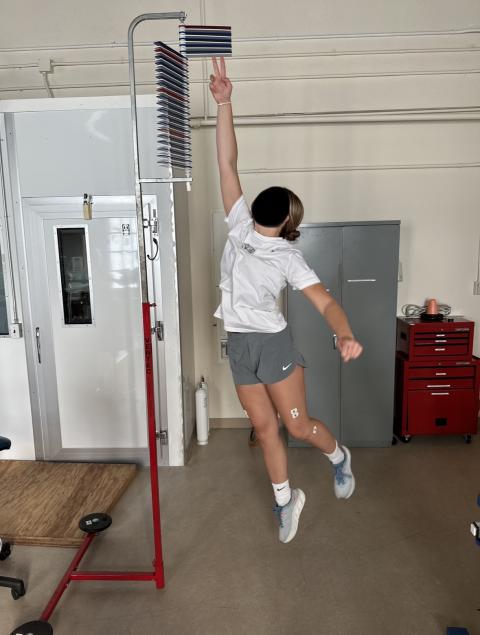
Subject performing single-leg vertical jump using the Vertec.
Female collegiate athletes, such as volleyball and basketball players, frequently experience unilateral fatigue, as they perform several movements that require repeated force production from one limb. Thus, understanding mechanisms of fatigue is beneficial for designing effective training plans that maximize performance by minimizing fatigue. The purpose of this Summer Undergraduate Research Fellowship (SURF) project, funded through the Hamel Center for Undergraduate Research, was to induce unilateral fatigue in the dominant leg muscles of female collegiate athletes and then evaluate subsequent force production, muscle activation, and vertical jump performance in both the exercised and non-exercised limbs.
I recruited fifteen female Division I athletes for the study: ten volleyball players and five basketball players. Participants visited the Robert Kertzer Exercise Science Laboratory in New Hampshire Hall for a familiarization visit and a testing visit, each ninety minutes for a total of three hours of participation. Subjects were instructed to avoid exercise, alcohol, and caffeine twenty-four hours before their visits.
Visit 1: Familiarization
Each subject read and completed the informed consent, a Physical Activity Readiness Questionnaire, and a sport and health history survey. I measured the subject’s height and weight and familiarized them with movements that would be performed during the testing visit: single- and double-leg vertical jumps using a Vertec, maximal voluntary contractions to test the strength (force production) of the knee extension (quadriceps) and knee flexion (hamstrings) movements on an isokinetic dynamometer, and ten repetitions of the fatigue protocol described below for practice.
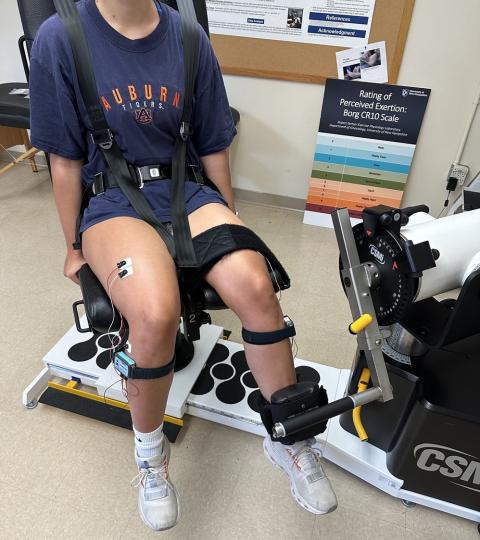
Subject seated in the isokinetic dynamometer. Knee extension occurs when the subject pushes their leg up against the pad, whereas knee flexion occurs when the subject pulls their leg back towards the chair.
Visit 2: Testing
Each subject’s height and weight were measured again, and their body composition was assessed using the InBody machine to determine percent body fat and muscle mass. I assessed pre-measurements of vertical jumps using the Vertec. First, I measured each participant’s standing reach height by asking them to extend their hand as high as possible and line it up with markers on the apparatus. Then they jumped as high as possible while using their hand to push away the markers, and the difference between their maximum jump height and standing reach height was recorded as their vertical jump. Each participant performed three different jumps: exercised single-leg, non-exercised single-leg, and double-leg. To allow assessment of pre-measurements of muscle strength, participants performed three to five maximal voluntary contractions for both knee extension and knee flexion on each leg. Pre-measurements are shown in Figure 1.
Participants then performed a fatigue protocol on the dominant (exercised) leg only: five sets of thirty consecutive knee extension and knee flexion contractions at 180° s-1, a commonly used moderate speed, with thirty seconds of rest between sets. Immediately after the protocol, the subject performed one knee extension and knee flexion maximal voluntary contraction on each leg and two trials of each jump as post-test measures. Post-test measures were repeated fifteen minutes post-fatigue protocol to observe recovery from fatigue.
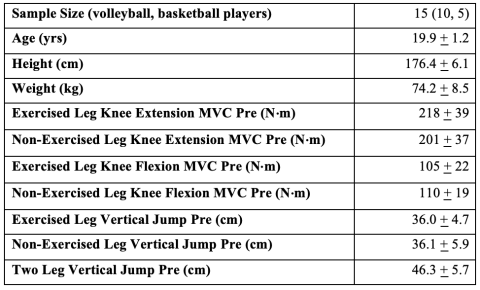
Figure 1. Demographics and pretest values of female volleyball and basketball players presented as means and standard deviations. Maximal voluntary contractions (MVCs) were measured in units of torque, or rotational force (N-m).
Preliminary Findings
Data was analyzed using repeated measures of analysis of variance (ANOVA) and paired samples t-tests. Vertical jump performance significantly decreased from pre- to immediately post-fatigue protocol (Figure 2). As anticipated, in the leg that performed the fatigue protocol, both knee extension and knee flexion maximal voluntary contractions were significantly lower immediately and 15 minutes post-exercise (Figure 3), indicating that there was fatigue of the quadriceps and hamstrings following the protocol and the muscles were not recovered after 15 minutes.
Surprisingly, in the non-exercised leg, knee extension maximal voluntary contraction force actually significantly increased from pre- to immediately post-fatigue protocol (Figure 3). The finding of increased force production in the non-exercised leg after the fatigue protocol is a noteworthy discovery that may challenge the existing literature, which has most frequently found either decreased force production or no change in the non-exercised leg (3).
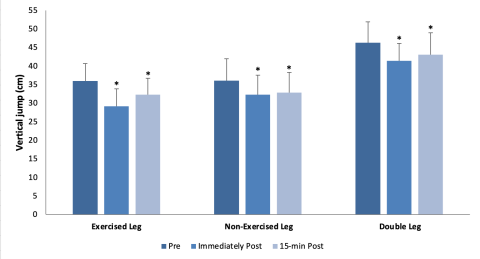
Figure 2. Mean (+/-S.D.) vertical jump height for jumps on the exercised leg, non-exercised leg, and double-leg at: pre-, immediately post-, and 15-minutes post-fatigue protocol. *Denotes significant difference from pre-fatigue protocol.
Interestingly, there is only one known study among crossover fatigue literature that also found increased force production in the non-exercised leg (4); however, the authors simply attributed this to a lack of warm-up or familiarization protocol. Our study, in which a thorough familiarization protocol was implemented, challenges the rationale of the Strang et al. (4) study and warrants further investigation. These findings may be attributed to each half of the motor cortex of the brain controlling one side of the body. During unilateral exercise, studies have shown activation of both halves of the motor cortex, which may excite the muscles of the resting limb (5) and contribute to increased force production of the non-exercised leg after the fatigue protocol.
Significance
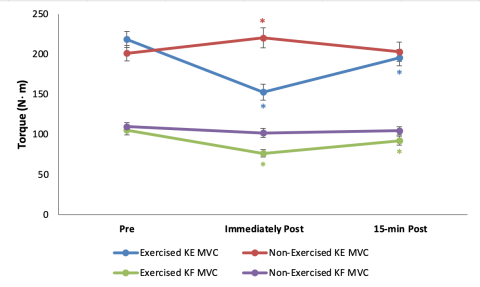
Figure 3. Mean (+/- S.E.) torque of knee extension (KE) and knee flexion (KF) in the exercised and non-exercised legs over three time points: pre-, immediately post-, and 15-minutes post-fatigue protocol. *Denotes significant difference from pre-fatigue protocol.
This study provides insight into how fatigue affects both exercised and non-exercised muscles, which is especially important to coaches and strength and conditioning professionals for effective practice and program design. Implementing a study population of volleyball and basketball players combined with the testing measure of both single- and double-leg vertical jumps, which are major movements in these sports, provided an applicable, sport-specific research approach. By observing fatigue under both exercised and non-exercised conditions, this study provides insight into the mechanisms of fatigue and works to bridge the gender disparity in the literature by adding to the sparse body of research on crossover fatigue in female subjects.
Working with human subjects gave me a better understanding of the importance of consistency with explanation, procedures, and instruction. It also taught me to be a more empathetic researcher and person, from subject considerations during the institutional review board (IRB) application to encouraging subjects through the discomfort of the fatigue protocol. Currently, I am in the process of writing my senior Honors thesis. I am excited to finish this project, present my research at the Undergraduate Research Conference and Grimes Competition in the spring, and submit a manuscript for publication in a peer-reviewed journal.
I would like to extend a huge thank you to my mentor, Dr. Cook, not only for all her help with this project, but for always encouraging me and challenging me as a student, researcher, and person. Thank you to all students who helped with data collection this summer: Owen Daigle, Gabe Dennett, Mackenzie Cook, and Amanda Ares. I would also like to thank the Hamel Center for Undergraduate Research and Mr. Dana Hamel for funding this project. Lastly, thank you to all participants in this study.
References
- Tornero-Aguilera JF, Jimenez-Morcillo J, Rubio-Zarapuz A, Clemente-Suárez VJ. Central and Peripheral Fatigue in Physical Exercise Explained: A Narrative Review. International Journal of Environmental Research and Public Health. 2022;19(7):3909.
- Martin PG, Rattey J. Central fatigue explains sex differences in muscle fatigue and contralateral cross-over effects of maximal contractions. Pflügers Archiv - European Journal of Physiology. 2007;454(6):957–69.
- Halperin I, Chapman DW, Behm DG. Non-local muscle fatigue: effects and possible mechanisms. European Journal of Applied Physiology. 2015;115(10):2031–48.
- Strang AJ, Berg WP, Hieronymus M. Fatigue-induced early onset of anticipatory postural adjustments in non-fatigued muscles: support for a centrally mediated adaptation. Experimental Brain Research. 2009;197(3):245–54.
- Hendy AM, Chye L, Teo W-P. Cross-Activation of the Motor Cortex during Unilateral Contractions of the Quadriceps. Frontiers in Human Neuroscience. 2017;11:397.
Author and Mentor Bios
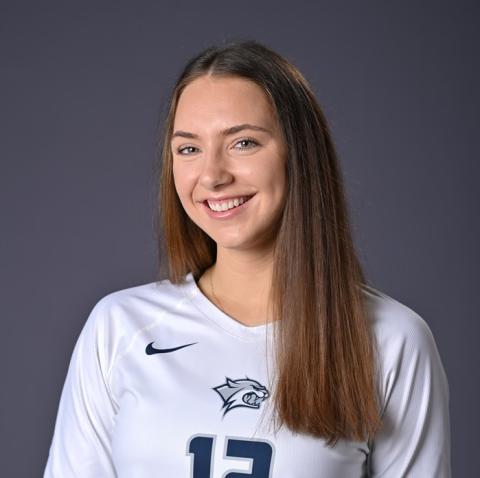
From Raleigh, North Carolina, Kelly R. Kaufmann is an exercise science major at the University of New Hampshire. As a captain of the women’s volleyball team and member of the Association of Exercise Science Students, Kelly’s interests allowed her to formulate and conduct muscle fatigue research in volleyball and basketball players for her Honors thesis with help from her mentor, Dr. Summer Cook. Funded by a Summer Undergraduate Research Fellowship (SURF) from the Hamel Center for Undergraduate Research, Kelly was able to spend the past summer obtaining priceless research skills including communication, hospitality, and perseverance through her work with human subjects. Despite the ongoing renovations of the research site, New Hampshire Hall, and series of obstacles that construction and recruitment challenges presented, Kelly was able to successfully complete her project. To Kelly, Inquiry serves as a great platform in which people can be exposed to and appreciative of various fields of research, which ultimately led her to the publication process. She is excited to complete the rest of her thesis and present her research in the spring.
Summer Cook is an associate professor in the Department of Kinesiology at the University of New Hampshire, where she has been since 2009. Her research focuses on improving human performance, particularly neuromuscular function through blood flow restricted exercise, in young adults, athletes, and older adults. Dr. Cook has served as a research mentor to over twenty different students who were awarded funding through the Hamel Center for Undergraduate Research. She has been mentoring and conducting research with Kelly for over a year. They combined interests to develop Kelly’s project to investigate fatigue patterns and the effects on athletic performance in female, collegiate volleyball and basketball players. She states that Kelly possesses strong scientific knowledge and outstanding writing skills that lead to the development of a sophisticated, undergraduate research study. She also describes Kelly as an efficient, independent researcher who always follows protocols and maintains high ethical standards. In Dr. Cook’s view, writing for Inquiry allows undergraduate student researchers to be creative in translating their research into understandable and meaningful results for readers not in their fields.
Copyright © Kelly R. Kaufmann
